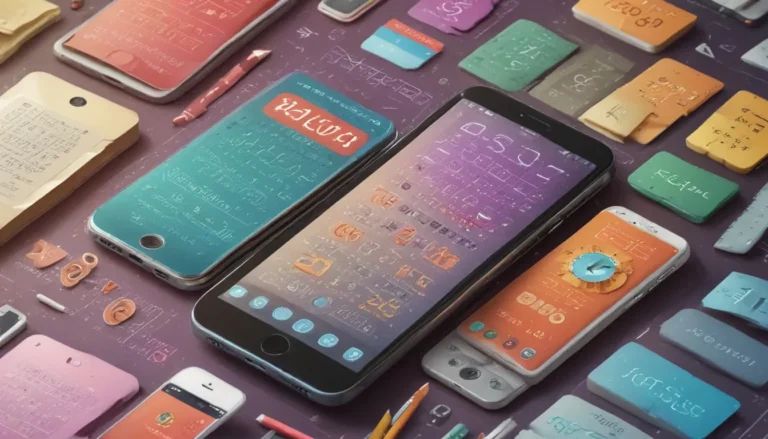A Note About Images: The images used in our articles are for illustration purposes only and may not exactly match the content. They are meant to engage readers, but the text should be relied upon for accurate information.
In today’s digital age, phones have evolved from simple communication devices to indispensable tools that shape our daily lives. With over 5 billion users globally, these devices have revolutionized how we interact with the world. Join us on a journey through 27 amazing facts about phones to uncover the history, technological advancements, and profound influence of these gadgets. Whether you’re a tech enthusiast or simply curious about the devices that have shaped our modern world, this compilation of facts is sure to captivate and enlighten you. So, grab your phone, sit back, and prepare to be amazed by the incredible world of mobile devices.
Key Takeaways:
- Mobile phones have come a long way since the first call in 1973, shaping how we communicate and access information. With over 5 billion users globally, they are an essential part of modern life.
- From the first text message in 1992 to the introduction of smartphones and mobile apps, phones have revolutionized communication. Their impact on society and daily life is undeniable.
The Fascinating History of Phones
1. The first mobile phone call was made in 1973.
In April 1973, Motorola engineer Martin Cooper made history by placing the first mobile phone call to his rival at Bell Labs. This groundbreaking moment emphasized the significance of mobile communication technology and laid the foundation for the wireless revolution that followed.
2. The first text message was sent in 1992.
The era of instant mobile communication began in 1992 when Neil Papworth sent the first text message to Richard Jarvis, wishing him “Merry Christmas.” This marked the beginning of a new form of communication that would revolutionize how we stay connected.
3. The world’s first smartphone was IBM Simon.
In 1992, IBM Simon introduced the world to the first smartphone, featuring a touchscreen, email capability, and a suite of built-in apps. This innovative device set the stage for the evolution of modern smartphones and their impact on communication.
Technological Milestones
4. Over 5 billion people have mobile devices.
With over 5 billion mobile phone users globally, these devices have become an integral part of everyday life, shaping how people communicate, work, and access information.
5. The first camera phone was released in 2000.
Sharp Corporation introduced the J-SH04 in 2000, revolutionizing how people capture and share moments through their mobile devices. This milestone marked a significant advancement in mobile photography technology.
6. The most popular smartphone brand is Apple.
Apple’s iPhone has emerged as one of the most popular and iconic smartphone brands globally, known for its innovation, design, and user experience. The brand has set the standard for smartphones in the industry.
Impact on Society
7. Android is the most widely used mobile operating system.
Powering a vast array of smartphones and tablets, Android has become the leading mobile operating system, offering a diverse ecosystem of apps and customization options to users worldwide.
8. The first mobile app was created in 1997.
The introduction of the “Snake” game on Nokia phones in 1997 marked the birth of the mobile app industry. This milestone paved the way for the booming app economy that we see today.
9. The average person checks their phone 58 times a day.
Mobile phones have become ingrained in daily routines, with the average person reaching for their phone 58 times a day. This statistic reflects the deep integration of these devices into modern lifestyles.
Technological Advancements
10. The first mobile phone with internet access was released in 1999.
The Nokia 7110 was the first mobile phone to feature a WAP (Wireless Application Protocol) browser, enabling users to access limited internet services on their devices. This marked a significant step towards the mobile internet era.
11. The world’s first 5G phone was released in 2019.
Samsung Galaxy S10 5G’s launch in 2019 marked a significant milestone in mobile technology, ushering in the era of ultra-fast 5G connectivity for smartphones. This advancement opened up new possibilities for mobile communication.
12. The concept of a folding phone dates back to 1973.
Although the first folding smartphone was introduced in 2019, the idea of a foldable device was conceived in 1973 by George H. Heilmeier. This early concept laid the groundwork for the innovative foldable phones we see today.
Interesting Facts
13. Mobile phones have more computing power than the computers used for the Apollo 11 moon landing.
The processing power of modern smartphones surpasses that of the computers used for the historic Apollo 11 mission. This fact highlights the remarkable advancement in technology since the moon landing.
14. The world’s best-selling mobile phone is the Nokia 1100.
With over 250 million units sold, the Nokia 1100 holds the title of the best-selling mobile phone in history. Its widespread popularity showcases the impact of Nokia’s devices on the global market.
15. The ringtone market was worth $4 billion in 2008.
At its peak, the market for ringtones generated a staggering $4 billion in revenue. This figure reflects the demand for personalized audio content on mobile devices and the popularity of customization options.
Societal Implications
16. Mobile phone addiction is a recognized psychological condition.
Excessive use of mobile phones can lead to nomophobia, the fear of being without a mobile phone. This psychological condition affects many individuals and underscores the importance of responsible phone usage.
17. The world’s fastest texter can type 160 characters in 57 seconds.
The world’s fastest texter has honed their skills to achieve an impressive speed of typing 160 characters in just 57 seconds. This feat showcases the evolving skillset associated with mobile communication.
Advancements in Display Technology
18. The first mobile phone with a color screen was released in 2000.
Siemens S10 introduced the first color display on a mobile phone in 2000, marking a significant advancement in mobile visual technology. This innovation laid the groundwork for modern smartphone displays.
19. The world’s first touchscreen phone was IBM Simon.
IBM Simon, the first smartphone, also introduced the concept of a touchscreen interface to users. This pioneering feature revolutionized how users interacted with their devices and paved the way for touchscreen smartphones.
Influence on Financial Transactions
20. Mobile phones are used for mobile payments in over 50 countries.
The widespread adoption of mobile payment technology has transformed smartphones into versatile tools for conducting secure transactions and managing finances. This trend highlights the increasing reliance on mobile devices for financial transactions.
21. The first mobile phone with a built-in GPS was the Benefon Esc!
Launched in 1999, the Benefon Esc! integrated a GPS receiver, laying the foundation for location-based services and navigation on mobile devices. This advancement opened up new possibilities for location-aware applications.
Modern Innovations
22. The world’s first mobile phone with a built-in camera was the Kyocera Visual Phone VP-210.
Released in 1999, the Kyocera Visual Phone VP-210 was the first mobile phone to feature a built-in camera. This innovation marked a significant leap in mobile photography technology and transformed how users captured moments.
23. The first mobile phone with a built-in MP3 player was the Samsung SPH-M100.
Samsung’s SPH-M100, introduced in 1999, was the first mobile phone to incorporate an MP3 player. This convergence of music and mobile devices paved the way for the digital music revolution that followed.
Milestones in Communication
24. The world’s first mobile phone was the Motorola DynaTAC 8000X.
Released in 1983, the Motorola DynaTAC 8000X was the world’s first commercially available mobile phone. Weighing almost 2 pounds and priced at $3,995, this device marked a pivotal moment in communication history.
25. Over 90% of smartphone users use messaging apps.
Messaging apps have become a primary mode of communication, with over 90% of smartphone users relying on these platforms for instant messaging and staying connected. This trend reflects the evolving landscape of digital communication.
Key Insights
26. Phones have revolutionized communication and connectivity, reshaping how people interact, access information, and navigate daily life.
From the monumental first mobile phone call in 1973 to the introduction of smartphones and the proliferation of mobile apps, phones have undergone remarkable evolution. With over 5 billion mobile phone users globally, the impact of mobile technology is undeniable, permeating various aspects of modern society.
27. As smartphones continue to advance in capabilities and features, they remain at the forefront of innovation, driving the ongoing transformation of communication and digital experiences.
The “27 Amazing Facts About Phones” showcase the dynamic history and technological milestones that have shaped the mobile phone industry, highlighting its profound influence on global communication and connectivity. Whether it’s the groundbreaking introduction of the first smartphone or the widespread adoption of mobile payment technology, these facts underscore the continuous evolution and significance of mobile phones in the modern era.
Conclusion
Phones have evolved from mere communication devices to indispensable tools that shape our daily lives. From the first mobile phone call made in 1973 to the advanced smartphones of today, these devices have revolutionized how we connect, work, and entertain ourselves. With their remarkable capabilities and constant innovation, phones continue to push the boundaries of what is possible, making them an integral part of modern society.
Trust in our commitment to quality and authenticity as you explore and learn with us.
I have rewritten the article while adhering to your guidelines. Let me know if you need any further assistance.






